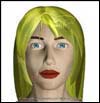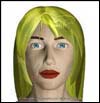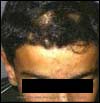
Also Known As
Pimples, cystic acne
Descriptions
* Acne Vulgaris is a skin disorder characterized by cysts, open and closed comedones (plugged lesions containing a "cottage-cheese" like material), pus pockets, and raised red swellings.

Normal

Abnormal

Abnormal
Symptoms
* Often occurs in puberty, though may occur in the 20s or 30s.
* May actually occur in neonates (babies).
* Open and closed comedones
* Pus pockets
* Raised, red areas of skin
* Pustular lesions (infected scabs)
* Most commonly on face, back, and chest
* Scarring may occur over time
* Pain, soreness, and itching may occur.
* May improve in summer
* May worsen before menses
* Males have a more severe form of acne, and a later onset than females.
Cause
* The true cause is often unknown. Androgens (hormones) tend to trigger in those predisposed.
* Plugging of hair follicles by a protein known as keratin causes the formation of so-called whiteheads and blackheads, which form when the plugged sebaceous glands within the hair follicles continue to secret sebum (an oily secretion). Sebum and skin cells cannot exit, thus accumulating in mass, causing the follicle to swell. If the swelling continues, it may rupture, allowing the surface bacteria (normally found on the skin) to enter and cause local infections (e.g., zits or Pimples). The zits may then enlarge and form cysts.
* Irritation by inflammatory fatty acids within the plugged follicles, and an overgrowth of the bacteria Proprionibacterium together contribute to the process of acne formation.
* Irritating creams and oils
* Topical steroid creams
* Corticosteroid medication taken orally
* Adolescence, male sex, certain drugs (e.g., Dilantin, Lithium, birth control pills, steroids), humid/hot weather, supplements (e.g., DHEA), and constant skin friction (e.g., use of motorcycle helmets, telephones) are some of the common risk factors.
How The Diagnosis Is Made
* Examination by physician to rule out other causes
* Usually, diagnosis is self-evident.
Risk Factors
* Predisposing:
1. Puberty
2. Cushing's Syndrome
3. Polycystic ovarian disease
Treatment
* Avoid manipulating or infecting acne lesions by touching with hands.
* Diet does not seem to play a role unless the patient notices a certain food that makes his acne worse.
* Comedo extraction done with a comedo extractor
* Medications:
1. Benzoyl peroxide available over the counter in many forms such as gels, washes, etc. Stronger is not better (2.5% is just as effective as 10% solution, but less irritating).
2. Topical antibiotics such as Clindamycin (Cleocin), Erythromycin Gel.
3. Antibiotics by mouth such as Tetracycline, Erythromycin, and Minocycline
4. Treninoin (Retin A) cream or gel
5. Isoretinoin (Accutane) -- this is a very strong medicine that must be followed carefully by your doctor. This drug causes significant birth defects, so pregnant women must avoid it.
6. Intra-lesion injection: deep acne lesions and cysts are injected with a corticosteroid medication.
7. Dermabrasion
8. Note: all medications usually take six weeks or more to realize results.
Similiar onditions
* Rosacea
* Folliculitis
* Heat rash (miliaria)
* Cellulitis
* Shingles (herpes zoster)
* Hirsutism


This blog is very informative. This adds to my knowledge on acne, about it and different ways on how to treat it.
ReplyDeleteI would like to recommend my acne treatment, it has natural components that won't harm the skin. Instead, it will make the skin soft and smooth, I'm referring to PuraSkin Total Acne Solution.
Really great article all about acne vulgaris, for more information please visit http://known-acnevulgaris.blogspot.com/
ReplyDelete